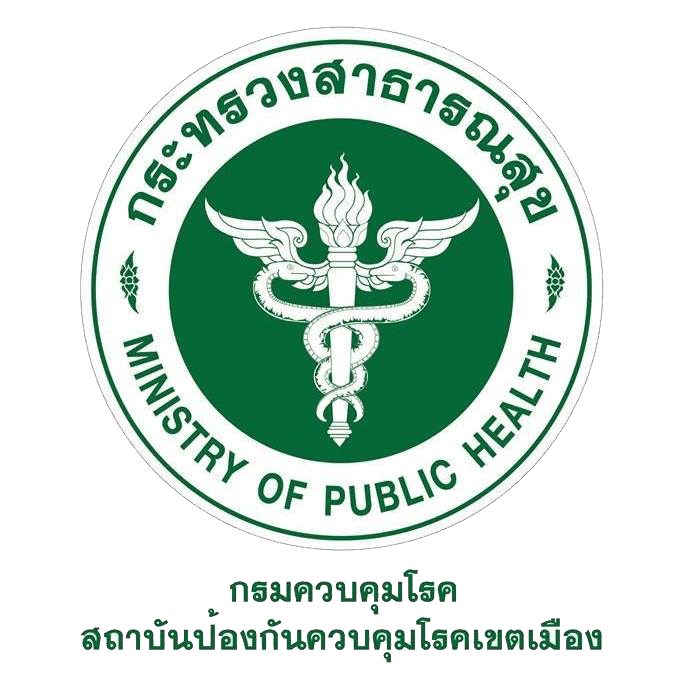ลักษณะคุณภาพอากาศต่างฤดูกาลของแผนกผู้ป่วยนอกในโรงพยาบาลเขตภาคเหนือตอนล่าง
Main Article Content
บทคัดย่อ
แผนกผู้ป่วยนอกของโรงพยาบาล เป็นจุดแรกที่ผู้มารับบริการนั่งรอรับการคัดกรอง การตรวจวินิจฉัยอาการหรือโรคจากแพทย์เพื่อทำการรักษา ดังนั้นหากพื้นที่นี้มีการจัดระบบระบายอากาศไม่เหมาะสม อาจเป็นแหล่งแพร่กระจายเชื้อโรคของผู้ป่วยสู่ผู้ที่มารอรับบริการได้ การศึกษานี้มีวัตถุประสงค์เพื่อศึกษาลักษณะคุณภาพอากาศในแผนกผู้ป่วยนอกของโรงพยาบาลระหว่าง 2 ฤดูกาล เลือกโรงพยาบาล 6 แห่ง ใน 5 จังหวัดภาคเหนือตอนล่าง โดยนับจำนวนคน ทั้งผู้รับบริการและผู้ให้บริการ ในแผนกผู้ป่วยนอก และตรวจวัดคุณภาพอากาศ ได้แก่ อุณหภูมิ ความชื้นสัมพัทธ์ คาร์บอนไดออกไซด์ คาร์บอนมอนอกไซด์ สารอินทรีย์ระเหยง่าย อนุภาค PM10 PM2.5 และเก็บตัวอย่างอากาศตรวจเชื้อราและแบคทีเรีย ในฤดูร้อน (พฤษภาคม-มิถุนายน 2559) และ ฤดูฝน (สิงหาคม-กันยายน 2559) ผลการศึกษา พบว่า ระดับอุณหภูมิในช่วงฤดูร้อน มีค่าเฉลี่ยเท่ากับ 33.2 (28.7 – 36.3) oC และฤดูฝนเท่ากับ 31.6 (28.0 – 33.7) oC (p < 0.001) ความชื้นสัมพัทธ์ในช่วงฤดูร้อนมีค่าเฉลี่ยเท่ากับ 55.3 (40.2 – 74.1) % และฤดูฝนเท่ากับ 62.1 (49.2 – 77.3) % คาร์บอนไดออกไซด์ ในช่วงฤดูร้อนมีค่าเฉลี่ยเท่ากับ 751.1 (488 – 1,528) ppm และฤดูฝนเท่ากับ 814.3 (516 – 1,783) ppm ปริมาณอนุภาค PM10 ในช่วงฤดูร้อนมีค่าเฉลี่ยเท่ากับ 66. (10.7 – 194.1) µg/m3 และช่วงฤดูฝนเท่ากับ 94.1 (16.3 – 233.5) µg/m3 เชื้อแบคทีเรียมีในช่วงฤดูร้อนมีค่าเฉลี่ยเท่ากับ 1,549 (307 – 3,087) CFU/m3 และฤดูฝนเท่ากับ 1,340 (320 – 3,727) CFU/m3 (p = 0.11) ในขณะที่เชื้อราในช่วงฤดูร้อนมีค่าเฉลี่ยเท่ากับ 364.6 (154 – 634) CFU/m3 และช่วงฤดูฝน 841.3 (194 – 1,734) CFU/m3 (p < 0.001) ผู้รับบริการ ในช่วงฤดูร้อนมีค่าเฉลี่ยเท่ากับ 334 (10 – 1,200) คน และช่วงฤดูฝน 310 (50 – 880) คน (p < 0.001) ดังนั้น ระดับคาร์บอนไดออกไซด์ และอนุภาคขนาดเล็กจะเพิ่มขึ้นตามจำนวนคนมารับบริการแต่ละช่วงเวลาของวัน และอุณหภูมิ ความชื้นสัมพัทธ์ คาร์บอนไดออกไซด์ อนุภาคขนาดเล็ก เชื้อรา มีความแตกต่างกันใน 2 ฤดูกาล ทั้งนี้อุณหภูมิทั้ง 2 ฤดูกาลไม่อยู่ในช่วงที่เหมาะสมตามค่าอ้างอิง (ASHRAE 55-1992) ลักษณะของคุณภาพอากาศในแผนกผู้ป่วยนอกขึ้นกับจำนวนคนมารับบริการ ช่วงเวลา 08.00 - 11.00 น. จึงควรจัดการระบายอากาศเพิ่มเติมเพื่อช่วยให้มลพิษในบรรยากาศลดลง โดยเฉพาะช่วงฤดูฝน
Article Details

อนุญาตภายใต้เงื่อนไข Creative Commons Attribution-NonCommercial-NoDerivatives 4.0 International License.
บทความที่พิมพ์ในวารสารสถาบันป้องกันควบคุมโรคเขตเมือง ถือว่าเป็นผลงานวิชาการ งานวิจัยและวิเคราะห์ ตลอดจนเป็นความเห็นส่วนตัวของผู้เขียนเอง ไม่ใช่ความเห็นของสถาบันป้องกันควบคุมโรคเขตเมือง หรือคณะบรรณาธิการแต่ประการใด ผู้เขียนจำต้องรับผิดชอบต่อบทความของตน
เอกสารอ้างอิง
สมชัย บวรกิตติ, บรรณาธิการ. ตำราเวชศาสตร์สิ่งแวดล้อม =Environmental Medicine. กรุงเทพฯ: เรือนแก้วการพิมพ์; 2542.
นภดนัย อาชาคม. คุณภาพอากาศภายในอาคาร. สไลด์ประกอบการบรรยาย 59 หน้า. [อินเตอร์เน็ต]. [ม.ป.ป.] [เข้าถึงเมื่อ 1 กันยายน 2565]. เข้าถึงได้จาก: https://www.slideshare.net/ThitipornKlainil/1-7499580
สุพจน์ เดชะอำนวยวิทย์. การตรวจวัดคุณภาพอากาศในอาคาร บทความวิชาการชุดที่ 14. สมาคมวิศวกรรมปรับอากาศแห่งประเทศไทย[อินเตอร์เน็ต]. [ม.ป.ป.] [เข้าถึงเมื่อ 1 กันยายน 2565]. เข้าถึงได้จาก: https://www.acat.or.th/download/acat_or_th/journal-14/14%20-%2009.pdf
กฤษณา กาทอง. คู่มือการปฏิบัติงานเพื่อการตรวจประเมินคุณภาพอากาศภายในอาคาร สำหรับเจ้าหน้าที่[อินเตอร์เน็ต]. สำนักอนามัยสิ่งแวดล้อม กรมอนามัย กระทรวงสาธารณสุข; 2559 [เข้าถึงเมื่อ 1 กันยายน 2565]. เข้าถึงได้จาก: http://ghh.anamai.moph.go.th/storage/app/uploads/public/603/b5b/072/603b5b0720697166916487.pdf
Chaivisit P, Fontana A, Galindo S, Strub C, Choosong T, Kantachote D, et al. Airborne bacteria and fungi distribution characteristics in natural ventilation system of a university hospital in Thailand. EnvironmentAsia [Internet]. 2018 [cited 2022 Oct 6];11(2):53-66. Available from: http://tshe.org/ea/pdf/EA11(2)_05.pdf
Brown SK, Sim MR, Abramson MJ, Gray CN. Concentration of volatile organic compounds in Indoor air – A review. Indoor Air [Internet]. 1994 Jun [cited 2022 Oct 6];4(2):123–134. Available from: https://onlinelibrary.wiley.com/doi/abs/10.1111/j.1600-0668.1994.t01-2-00007.x
นินนาท ราชประดิษฐ์, จุฑาวัชร สุวรรณภพ, นฤพล สร้อยวัน. การศึกษาผลกระทบของรูปแบบการระบายอากาศที่มีต่อระดับความชื้นสัมพัทธ์ภายในสำนักงานที่ใช้เครื่องปรับอากาศแบบแยกส่วน. Naresuan University Journal. 2013; Special Issue:17-23.
United States Environmental Protection Agency [Internet]. US: 2016. Particulate Matter (PM) Standards -Table of Historical PM NAAQS; 2016 [cited 2022 Sep 1]; [about 1 screens]. Available from: http://www3.epa.gov/ttn/naaqs/standards/pm/s_pm_history.html
Nathanson T. Indoor air quality in office buildings: A technical guide. Canada: Minister of National Health and Welfare; 1995.
พรชรัฐ สายยุทธ, กัลยา หาญพิชาญชัย, จินดาวัลย์ วิบูลย์อุทัย. ปริมาณเชื้อจุลินทรีย์ในอากาศและคุณภาพอากาศในอาคารของโรงพยาบาล : กรณีศึกษาโรงพยาบาลนครพิงค์ จังหวัดเชียงใหม่. วารสารวิชาการสำนักงานป้องกันควบคุมโรคที่ 9 จังหวัดนครราชสีมา [อินเทอร์เน็ต];26(1):14-24. เข้าถึงได้จาก: https://he02.tci-thaijo.org/index.php/ODPC9/article/view/239237
ปานทิพย์ ธิโนชัย, มนทิรา เตี้ยเล็ก, จิรา คงปราณ. คุณภาพอากาศภายในอาคารโรงพยาบาล: กรณีศึกษา โรงพยาบาลชุมชนแห่งหนึ่งในจังหวัดนครศรีธรรมราช. วารสารวิชาการสาธารณสุข. 2562;28(2):325-33.
สุวัฒน์ ดำนิล. การสำรวจระดับความเข้มข้นและการจำแนกชนิดของแบคทีเรียและเชื้อราในอากาศภายในอาคารของโรงพยาบาลศิริราช [วิทยานิพนธ์ปริญญาวิทยาศาสตร์มหาบัณฑิต]. กรุงเทพฯ: มหาวิทยาลัยมหิดล; 2552.
ก้องนภา อุทังสังข์, กาญจนา นาถะพินธุ. ชนิดและปริมาณเชื้อจุลินทรีย์ในอากาศ แผนกผู้ป่วยนอกของโรงพยาบาลสรรพสิทธิประสงค์ จังหวัดอุบลราชธานี. วารสารสำนักงานป้องกันควบคุมโรคที่ 7 ขอนแก่น. 2561;25(2):14-21.
ศิริพร ศรีเทวิณ, กาญจนา นาถะพินธุ. การปนเปื้อนเชื้อจุลินทรีย์ในบรรยากาศในโรงพยาบาลขนาดที่แตกต่างกัน. วารสารวิจัย มข.(บศ.). 2555;12(1):92-101.
Leung M, Chan AHS. Control and management of hospital indoor air quality. Med Sci Monit. 2006;12(3):SR17-23.
บุญพงษ์ กิจวัฒนาชัย. EIT Article: no.010 อาคารสาธารณะ และอาคารทั่วไปควรใช้กับระบบปรับอากาศแบบรวมศูนย์หรือแบบแยกส่วน เพื่อความปลอดภัยจาก “การแพร่กระจายทางอากาศ (Airborne)” หรือ การติดเชื้อโควิด 19 [อินเตอร์เน็ต]. กรุงเทพฯ: EIT; 2563 [เข้าถึงเมื่อ 5 กันยายน 2565]. เข้าถึงได้จาก: https://eit.or.th/advertise/new/11-8-64airbone.pdf


